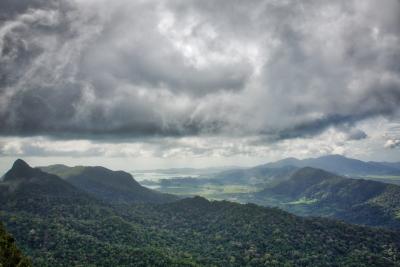How Increasing Carbon Dioxide Levels Affect Daytime Rainfall in Tropical Forests
Tropical forests are important and sensitive ecosystems that rely on large amounts of rainfall. Increasing atmospheric carbon dioxide, or CO2, changes the time of day when rain falls over tropical forests via two distinct physical mechanisms. Researchers illustrated these two pathways using the biogeochemically-enabled version of the Energy Exascale Earth System Model (E3SM). One such pathway involves the radiative response of the atmosphere to rising CO2, while the other involves plant responses to increased CO2 concentrations.
Knowing how rainfall patterns in both space and time will respond to increasing atmospheric CO2 is important for water management. This study sheds light on how the daytime cycle of rainfall over tropical forests responds to an increase in CO2. The identified pathways reduce daytime rainfall relative to nighttime, making the distribution of rainfall more uniform across the span of a day.
Tropical rainforests receive more rainfall than almost any other land area on Earth. Understanding the sensitivity of rainfall in these regions to increasing atmospheric CO2 concentrations is important for assessing the risks to the ecosystem and the people dependent on that rainfall. Currently, these areas have a strong day-night rainfall cycle. Using the biogeochemistry-enabled E3SM, scientists found that in response to rising CO2 tropical forest rainfall becomes more uniform throughout the day. They identified two distinct physical pathways that govern this change in the rainfall timing. The first pathway starts with increased CO2 leading to increased radiative heating. This results in a relative reduction in convective instability late in the day, producing less late-day rainfall (when climatological rainfall peaks). The second pathway starts with increased CO2 leading to a reduction in evapotranspiration. This produces a warmer, drier boundary layer that leads to an increased lifting condensation level and a reduction in late-day rainfall. The physical realism of these pathways suggests these responses are likely not restricted to E3SM and could be active under higher CO2 conditions.

